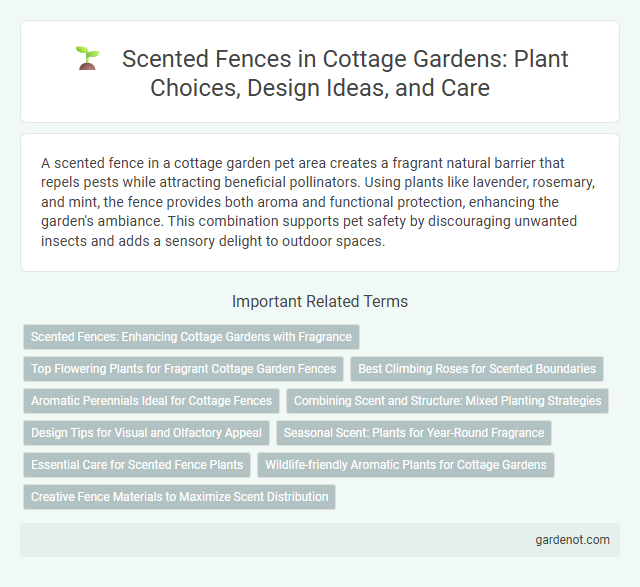A scented fence in a cottage garden pet area creates a fragrant natural barrier that repels pests while attracting beneficial pollinators. Using plants like lavender, rosemary, and mint, the fence provides both aroma and functional protection, enhancing the garden's ambiance. This combination supports pet safety by discouraging unwanted insects and adds a sensory delight to outdoor spaces.
Scented Fences: Enhancing Cottage Gardens with Fragrance
Scented fences in cottage gardens infuse outdoor spaces with natural fragrances from climbing plants like jasmine, honeysuckle, and clematis. These fragrant vines create a sensory experience while providing privacy and aesthetic appeal. Incorporating scented fences promotes biodiversity by attracting pollinators such as bees and butterflies, enhancing the garden's ecological balance.
Top Flowering Plants for Fragrant Cottage Garden Fences
Top flowering plants ideal for fragrant cottage garden fences include honeysuckle, climbing roses, and jasmine, prized for their intense, sweet aromas. These plants not only provide lush, colorful blooms but also attract pollinators like bees and butterflies, enhancing garden biodiversity. Incorporating species such as lavender and sweet pea can infuse the air with a continuous, pleasing fragrance throughout the growing season.
Best Climbing Roses for Scented Boundaries
Climbing roses like 'New Dawn,' 'Eden,' and 'Zephirine Drouhin' are ideal for creating scented boundaries in cottage gardens, offering a blend of strong fragrance and vibrant blooms. These varieties thrive when trained along fences, providing both privacy and a natural aroma that attracts pollinators such as bees and butterflies. Their vigorous growth and disease resistance make them a lasting, low-maintenance choice for enhancing the sensory appeal of garden fences.
Aromatic Perennials Ideal for Cottage Fences
Aromatic perennials such as lavender, rosemary, and garden thyme thrive along cottage fences, filling garden spaces with delightful scents while attracting pollinators like bees and butterflies. These hardy, fragrant plants not only enhance privacy but also create a sensory-rich boundary that complements the rustic charm of cottage gardens. Incorporating herbs like mint and catmint ensures continuous fragrance and seasonal blooms, making fences an integral aromatic feature.
Combining Scent and Structure: Mixed Planting Strategies
A scented fence enhances a cottage garden by integrating fragrant climbers like jasmine, honeysuckle, and clematis with sturdy trellises or wooden panels, creating both aromatic appeal and vertical structure. Incorporating evergreen shrubs such as rosemary or lavender at the base extends scent beyond blooming seasons while providing dense foliage for privacy. This strategic mix of flowering vines and perennial shrubs maximizes sensory impact and complements the rustic aesthetic of traditional cottage garden designs.
Design Tips for Visual and Olfactory Appeal
Incorporate climbing scented plants such as jasmine, honeysuckle, and climbing roses along the fence to enhance both fragrance and visual interest. Use a mix of evergreen and flowering varieties to maintain year-round appeal and introduce layered heights for depth. Choosing complementary colors and textures ensures the fence becomes a vibrant focal point that stimulates the senses.
Seasonal Scent: Plants for Year-Round Fragrance
Planting a scented fence in a cottage garden ensures year-round fragrance by incorporating seasonal blooms like lavender in summer, jasmine in spring, and winter honeysuckle for colder months. Herbs such as rosemary and thyme release refreshing aromas while climbing roses provide a sweet scent during late spring and early summer. These choices create a dynamic sensory experience that enhances the garden's charm throughout every season.
Essential Care for Scented Fence Plants
Scented fence plants require essential care including regular watering, well-drained soil, and adequate sunlight to thrive. Pruning spent blooms encourages continued flowering and maintains plant health. Applying organic mulch helps retain moisture and suppress weeds, ensuring vibrant fragrance and growth throughout the season.
Wildlife-friendly Aromatic Plants for Cottage Gardens
Scented fences in cottage gardens attract pollinators and beneficial insects by featuring wildlife-friendly aromatic plants like lavender, rosemary, and thyme. These herbs not only emit pleasant fragrances but also provide essential nectar and habitat for bees, butterflies, and hummingbirds. Incorporating such aromatic plants enhances biodiversity while creating a fragrant, visually appealing garden boundary.
Creative Fence Materials to Maximize Scent Distribution
Creative fence materials such as cedar, eucalyptus, and aromatic thyme create a scented fence that maximizes fragrance diffusion throughout a cottage garden. Integrating climbing plants like jasmine, honeysuckle, and lavender onto porous wooden or lattice fences enhances the natural scent release while adding visual charm. Using natural oils infused into resin panels or incorporating herb-filled pouches in vinyl fences can further amplify aromatic presence, creating an immersive sensory experience.
Scented fence Infographic

 gardenot.com
gardenot.com